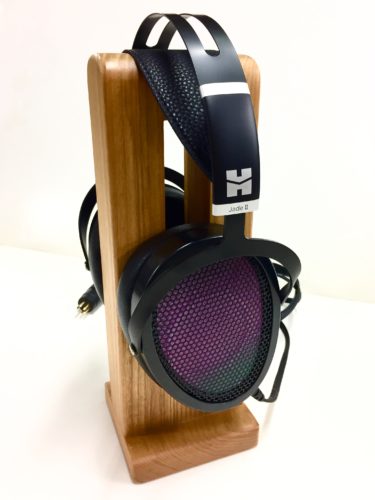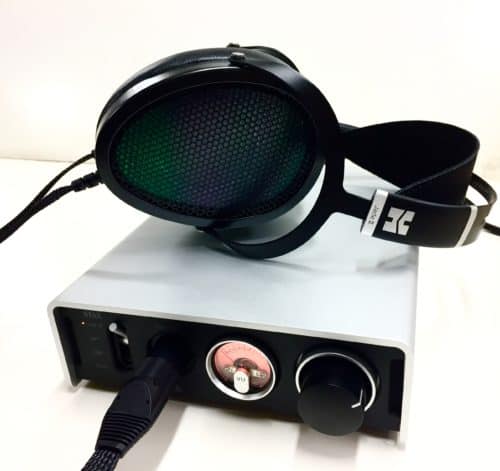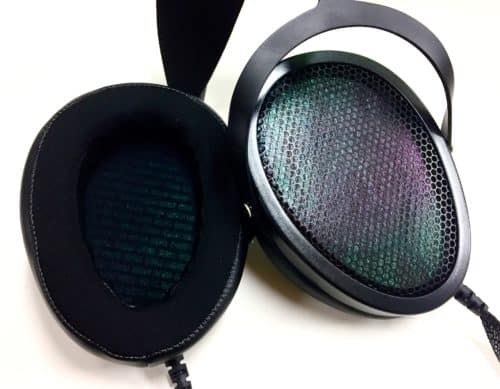Since its inception, Hifiman has been synonymous with the planar magnetic headphone, becoming, alongside Audeze, one of the foremost manufacturers of planars in the world. And they’re also one of my favorite manufacturers in general: I love the Sundara (which I own), the HE1000, and the HE5se. But the Hifiman Jade II is not a planar-magnetic headphone; rather, it’s electrostatic.
If you’ve been following Major HiFi’s activities over the last few days, you might notice that we’ve been publishing a lot of reviews of electrostatic headphones. Frankly, ever since we got our Stax demo units, the time has just seemed right somehow. So we’re back! with the Jade II, another electrostat.
The Jade II has something of a history to it. Back before Hifiman became its own company, its president, Dr. Fang Bian, was designing headphones for He Audio, where he designed the the original Jade. This headphone is sort of a unicorn in the audio world – apparently somewhere on the order of magnitude of 25 units were made in total.
The Jade II, on the other hand, is much like any other Hifiman headphone – but it’s electrostatic. It fills out the lower-priced range of Hifiman’s electrostatic headphones, alongside the $8,000 Shangri-La Jr. and the $50,000 Shangri-La. But the going price is still floating somewhere around $1,000, so it’s no drop in the bucket!
In the Box
Hifiman hasn’t been investing heavily in the unboxing experience as of late, with the Arya coming in the same cardboard box as their lower-end headphones, but I don’t think I’ve ever seen a more spartan presentation than the Jade II. Do all of the units come like this? It’s just in a foam case inside of the brown cardboard box in which it came. There’s no presentation, none at all.
Anyway, all this has precious little to do with my actual opinions on the headphones. I don’t place much value on the unboxing experience. But, it’s kinda funny…
Build, Comfort and Appearance
The build is much like many other of the “egg-shaped” line of Hifiman headphones – that is, the HE1000, Arya, Ananda, Edition X, etc. The difference is that the Jade II forgoes the windowshade-style screen for a hexagonal grid. Otherwise, it’s very much the Hifiman headphones you’re used to – not so well-built, but not flimsy either.
That said, the absence of the typical array of magnets allows the Jade II to be much lighter than your average Hifiman. These sit very lightly on the head, and so they don’t weigh you down at all.
Of course, I’ve expressed concern with Hifiman’s current-generation headband design. It’s not uncommon to point out that the yokes lack the ability to swivel side-to-side, meaning the earpads will rest against the head at an uncomfortable angle for some. Unfortunately, I found that to be the case with the Jade II – the headphones exert a bit more pressure in front of the ear than behind for me, so they become a tiny bit fatiguing over time. Also, there’s the typical concerns with the headband adjustment: it has a tendency to be either too stiff or too loose, and to vary heavily between units.
When it comes to appearance, the Jade II is dominated by its iridescent dust screen, which looks fantastic. I’m not sure if there’s any technical reason for the screen to look this way, but I don’t really care – it looks strikingly good.
Sound
For a primer on how I describe sound, refer to my article “How Headphones Sound (to me).”
As an electrostat, I assumed two things to be true about the Jade II:
- It’d be fast and detailed, with a kind of weightless sound, and…
- It wouldn’t sound like other Hifiman headphones.
Both of these assumptions were true. I’m two for two – I must be the luckiest person in the world! Vegas, baby, here I come!
Overall, I found the Jade II to carry enough speed and detail to be worthy of inclusion in the electrostatic pantheon. It also had quite a nice tuning – very neutral, much moreso than the equivalently-priced Stax headphones. However, they aren’t perfect, and one wouldn’t expect them to be – they’re not that expensive, at around $1,000, for an electrostat.
Bass
Electrostats tend to have somewhat lessened bass impact, because they don’t move too much air when producing bass frequencies. The Jade II mostly continues with that pattern – the bass here is both rolled-off and lacking in impact. If you want to enjoy heavy-hitting bass, you’re gonna need to look for a different pair of headphones – preferably not electrostats at all.
In fact, Hifiman is known for making headphones with great bass performance, and the low-impact bass is probably the most un-Hifiman-esque part of this headphone’s tuning. Still, you will hear what’s going on down there – you just won’t feel it.
Mids
Those who are used to listening to the electrostats from companies like Stax may be surprised by the Jade II’s midrange tuning – it’s far more accurate than any other sub-$2,000 electrostat I’ve heard, and it’s about as accurately-tuned as something like, say, the SR-009s. That is to say, it’s not 100% on target, but it’s pretty damn close.
Typical of Hifiman, there’s a little bit of recession in the mid-mids (between 1-2kHz). It doesn’t do much to the overall tonality of the headphone, but it does make it sound just a tiny bit – a really tiny bit – warmer than perfect diffuse-field neutrality. Really, the difference is very small, and not all that significant.
Resolution and Dynamics
Where you do lose out in the midrange is resolution; these are just a tiny bit less resolving than, say, the L700 (which is more expensive, I should add!). Instrument separation is still fantastic, and you still get a lot of juicy details, but there’s just a teensy bit more vagueness around the edges of sounds. Of course, if you’ve never heard an electrostat, you’ll be amazed at the detail on display here, but if you’re a daily electrostat user like me, you might notice a very small deficit in resolution. That small loss may be worth it for the gains in neutrality.
The same goes for dynamics. These headphones sound just a bit less slammy and dynamic than my own personal pair of Stax Lambda Pros.
Treble
Treble is again more even and less resolving than the SR-L700. In a couple of my less forgiving recordings, I noticed a little bit of tizz in the highs, just a very small amount. That’s relatively characteristic of Hifiman, so I’m not surprised to hear it, though it points to the headphone’s driver perhaps being not so cooperative at certain frequencies or being under-damped.
No matter! The treble is still very resolving for a headphone at this price point.
Soundstage
The Jade II has great instrument separation and a sense of wide-openness that comes with the nature of being an electrostat. Still, I couldn’t help but feel that the soundstage was slightly lacking, in width, depth, and image specificity. Instrument positions weren’t totally clear or pinpoint. Again, though, it’s a small price to pay.
Pros and Cons
Pros: Neutral tuning, winning detail and instrument separation
Cons: Dynamics can be lacking, lazy packaging
In Conclusion
If you’re looking to get into electrostats, the Hifiman Jade II isn’t a bad way to start. Priced at $2,499 with the Jade II amplifier, and $1,399 without, it’s not the cheapest elecrostat on the market, but it also really requires no equalization to get truly accurate sound – the same can’t be said of the lower-end Stax Lambdas, for example, which are definitely colored. I also find that the Jade II “threads the needle” between being true to life, accurate and uncolored, while also being relatively forgiving toward not-so-good recordings.
All in all, the Jade II system is recommendable indeed, but the electrostatic presentation is so different that I can’t recommend buying it blind. Compared to planar and dynamic headphones, some may find the Jade II a bit too ethereal-sounding. But for those interested in the electrostatic sound, the Jade II is a worthwhile option to check out.
Head to Audio46 to peep the system or the headphones by themselves.
They’re also available on Amazon – both the system and the headphones alone.
As a disclaimer, MajorHifi may receive commissions from retail offers.
MAJORHIFI may receive commissions from retail offers.












